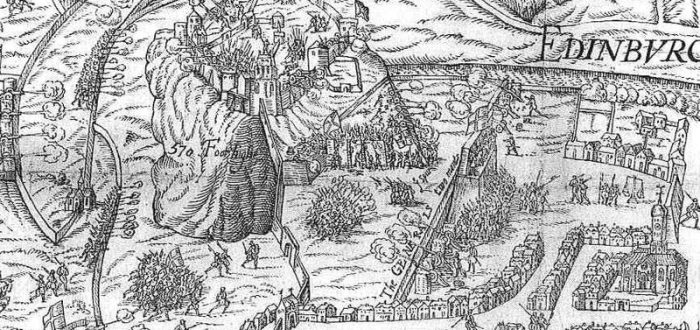Our History Lecturer, Dr Allan Kennedy, provides an overview of the short but vicious civil war that followed the deposition in 1567 of Mary, Queen of Scots. This article first appeared as part of the ’10 Minutes On…’ column in History Scotland magazine, with whose kind permission it is republished here.
The turbulent personal rule of Queen Mary I came to an end in 1567, when, incarcerated in the grim fortress of Loch Leven, she was forced to abdicate the throne in favour of her infant son, James VI. But Mary, famously, escaped from her prison the following year, quickly assembling an army and confronting her enemies at the battle of Langside. There was to be no triumphant restoration, however: her forces were defeated, and she responded by fleeing precipitously to England, remaining a prisoner of Elizabeth I until her execution nineteen years later.
Yet the queen’s flight did not immediately kill her cause. She was, after all, the anointed and undoubtedly rightful sovereign, and this air of legitimacy, combined with ties of kinship and patronage, personal ambition, and, to a lesser extent, religious considerations, ensured that many Scots remained loyal to her. Prominent among these ‘Queen’s Men’ were the Hamilton family, led by the Protestant James, earl of Arran and duke of Châtellerault, whose extensive influence and position as second-in-line to the throne gave Mary’s party significant clout.
Ranged against the queen’s partisans were the ‘King’s Men’, supporters of the baby James VI, but in reality led by his regent, and Mary’s half-brother, James, earl of Moray. This grouping tended to be vocal about the religious aspects of the conflict, setting themselves up as defenders of the Reformation again a Catholic queen, although they often cast Mary as a tyrant who deserved deposition on political grounds as well. While these issues undoubtedly influenced some, most of James’s partisans were probably driven by a similar sort of personal calculus, rooted in obligation and self-interest, as influenced Mary’s supporters.
In mid-1568, just after Mary’s flight, the ‘Queen’s Men’ were dominant in the south-west, in the Lanarkshire and Argyll areas, and in the far north and north-east, while the ‘King’s Men’ held sway elsewhere. Initial efforts by the ‘King’s Men’ to subdue some of these areas foundered with the assassination of Regent Moray early in 1570 (incidentally, the first assassination of a head of government anywhere in the word by means of a firearm), but support from Elizabeth I allowed them to stabilise their position and resume campaigning in Clydesdale. A six-month truce beginning in late 1570 merely postponed the conflict, and when it reignited, the ‘King’s Men’ were again on the offensive. Their capture of the Marian fortress of Dumbarton Castle in April 1571, followed in short order by the defection of several of Mary’s leading supporters, including the earls of Argyll and Cassillis, marked a decisive shift in the conflict.
With campaigns and defections continuing to shift the localities in favour of James’s party, the war increasingly came to focus on Edinburgh. The capital long resisted picking a side, largely taking its cue from the governor of Edinburgh Castle, William Kirkcaldy of Grange. But in April 1571, Grange declared for Mary, taking both castle and city with him. The ‘King’s Men’ could not feel secure until they pacified Edinburgh, and so began a long and grinding struggle for control of the capital. James’s supporters eventually managed to reoccupy the town itself in autumn 1572, but the castle – still arguably the most formidable fortress in the British Isles – obstinately held out.
Most of the remaining Marian partisans surrendered in the ‘pacification of Perth’ of February 1573, leaving the ‘Queen’s Men’ with little except Edinburgh Castle, where Grange still held out. But in April, the ‘King’s Men’ were finally able to turn English sympathy into substantial military support; a force of 1,000 English troops surrounded the castle and began bombarding it with their 27 siege guns. Grange resisted for twelve days, but finally, on 28 May, he surrendered, thereby bringing the Marian Civil War to a close and confirming the deposition of Queen Mary in favour of King James.
Further Reading
J.A. Dawson, Scotland Re-Formed, 1466-1587 (Edinburgh, 2007)
G. Donaldson, All the Queen’s Men: Power and Politics in Mary Stewart’s Scotland (London, 1983)
H. Potter, Edinburgh under Siege, 1571-1573 (Cheltenham, 2003)



Comments are closed.